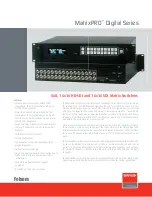
XG0440DC/XG0440DCR Hardware Guide
14
Laser Safety
The XG0440 may be installed with optical transceiver modules (SFP+ modules), which emit invisible laser light.
In the USA, these optical modules are certified as Class 1 laser products that conform to the requirements of the
Department of Health and Human Services (DHHS) regulation 21 CFR, Subchapter J. This certification is indicated by a
label attached to each optical module.
Outside the USA, these SFP+ modules are certified as Class 1 laser products that conform to the requirements of
EN60825-1 (2007).
Even when cables are not connected, invisible laser light may still be emitted from the optical module's port openings. To
avoid possible injury, do not look directly into the optical module's port openings.
Optical transceiver modules intended for use in the XG0440 must be selected from the Optical Transceiver Approved
Vendor List (obtainable from the vendor's service department).
Notes on Rack Mounting and Connecting a Powerstrip
•
Monitor and control the internal and external temperature and humidity of the rack, so that it does not exceed the range
of guaranteed operation temperature and humidity.
•
The air intake and exhaust of the device is conducted at the port side and Fan Unit side. Do not block the intake side or
exhaust side in order not to prevent airflow when installing.
•
Make sure to check the maximum loading capacity of the rack to be used for mounting.
•
Check the power supply capability of the installation location.
•
When connecting the power cable of the device to a powerstrip within a rack, a large amount of current leakage may
occur through the ground line of the powerstrip. Assure a good ground connection exists before connecting power to
the device. Assure power sourcing and leakage current carrying capabilities for the power strip are not exceeded. The
maximum current leakage for the device is 3.5 mA.
If mounting this device in a rack, assure device operational temperature specification compliance,
mechanical stability of the rack, and proper electrical grounding of the device. This device must only
be mounted in a rack by a qualified engineer with the required training and knowledge. Failure to do
so may result in property damage, electric shock, or fire.
Warning















































